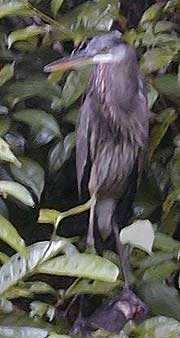|
||||
Literally the day I returned to our jungle camp in the remotes of the Toledo District from an overnight road trip to Belize City where we were lucky enough to find a new copy of H. Lee Jones' book entitled "Birds of Belize", we had a bird sighting second to none. It was the middle part of the afternoon on an extremely hot day as my machete man Clemento Pop and I were walking the front of the property talking about the possible good or bad implications surrounding the possibilities of building a fence along the front perimeter. In the land of the Maya fences are often viewed as intrusive to a culture that doesn't necessarily agree with fencing in the jungle. For it confuses the local population of Gibnuts, Iguanas and Pumas, not to mention the local hunters chasing them all. Just as Clemento and I were discussing the ramifications of fencing in the bush, we were suddenly both startled by the arrival on the dirt road in front of the property by, to put it mildly, a rather large bird. As our eyes darted away from the proposed thicket of palms where the fence line would have to be cut, both Clemento and I were totally absorbed by what appeared to be a huge bird. And as quick as the bird caught our collective attention, it flew up and over our heads and over the trees and out of sight. The
next morning as I sat on the back deck of my own personal cool
spot awaiting the arrival of Clemento to continue our discussion
regarding that fencing, I was reflecting upon the sheer natural
beauty which defines the Toledo District. It was still quite early,
not more than a handful of minutes following the sunrise when
I noticed along the edge of the jungle, where Clemento has meticulously
spent days upon days pushing back the jungle from the area dedicated
to our homestead, the same tall bird we had observed the previous
day, now standing tall and relaxed and seemingly without concern
for the existence of me or my house. |
||||
|
That's
about the time that I remembered the recent acquisition of Jones'
"Birds of Belize". I immediately tiptoed from the porch
of our kitchen champa to the house to retrieve the book for my
first field identification. As I returned to my point of observation
in the wooden deck chair bathing in the morning sun with both
the bird book as well as my digital camera in hand, the massive
bird became aware of my presence and decided it was time to take
to flight. As I stood silently the bird extended its wing and
began these rather slow and methodical motions, which represented
its approaches to flight.
Completely astonished by the wing span, I stood there in awe as the bird flew towards me before it banked left and over my head to make the tight squeeze between the roof of our house and the overhanging leaves of the thatch tied together for the roofing of the kitchen champa. I then ran back through the kitchen and out the front door to notice that the big bird was now settling down upon a tree branch to roost. Realizing that an encounter like this in the wild could be a once in a lifetime adventure, I began snapping photos of the bird as it stared back at me without contempt. I continued to photograph the bird as the moments seemed to last forever. With confidence I thought that just maybe I could get a little closer to zoom in upon the natural wonder that was granting this novice birdwatcher an exclusive showing and so I stepped off the wood decking and walked slowly towards the bird. But my reckless behavior startled the bird and in turn forced it to move from the comfort of the tree branch to find protective refuge further in the bush. |
As my heart continued to race, the bird regained its composure and settled down. I took a deep breath to click the shutter of my camera just one more time, as the bird poised and allowed me to capture the moment. And just as the camera completed its required mechanics to complete the photographic process, the bird extended its wings, flapped about awkwardly to free itself from the confines of the bush and then lifted up in order to soar up and over the roof of the kitchen champa for the wide open sky. With two circles around Clemento's well-defined perimeter to obviously get its coordinates for the flight that lied ahead, as quick as the arrival had been just as quick the bird was gone. That's when I finally turned to H. Lee Jones' "Birds of Belize" to determine just what had I seen. After turning the pages for referencing, there I found a Dana Gardner illustration on the Plate page Two for the Waders. The classification was for number eleven, Ardea Herodias, aka the Great Blue Heron, indeed, the largest bird in the skies over Belize. |
||||||








